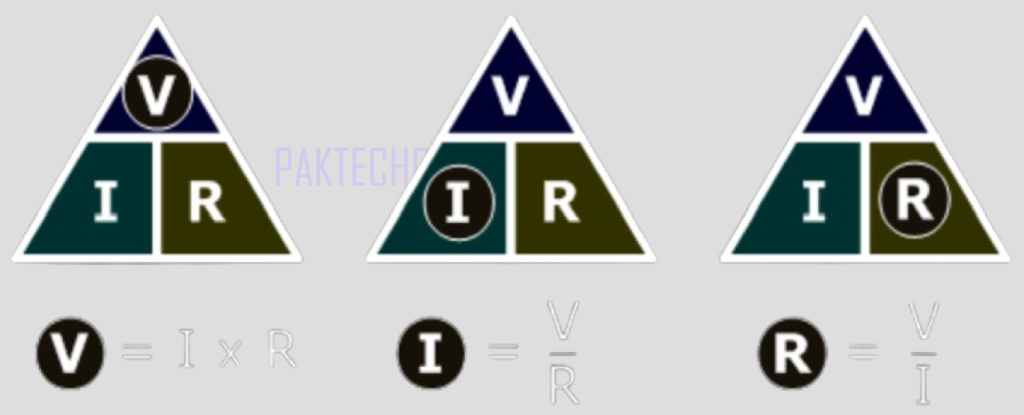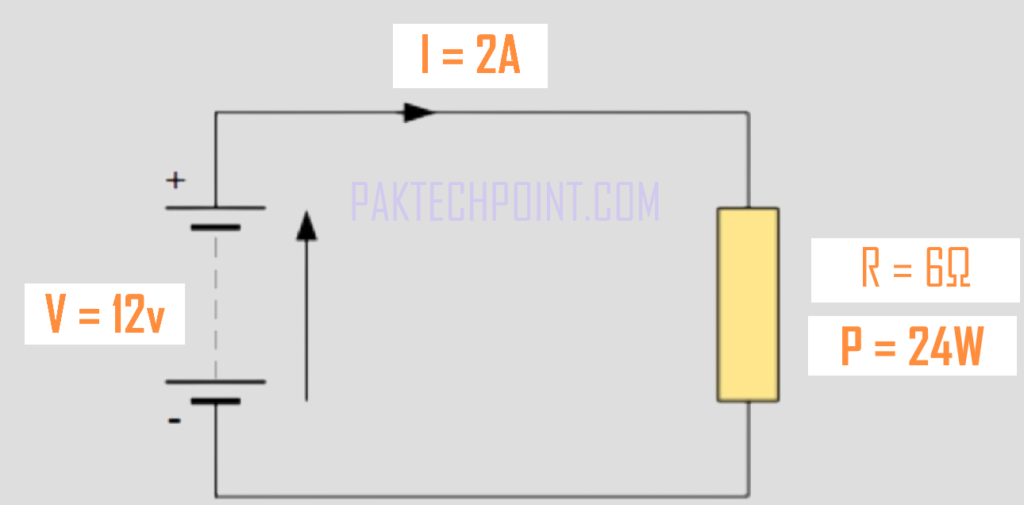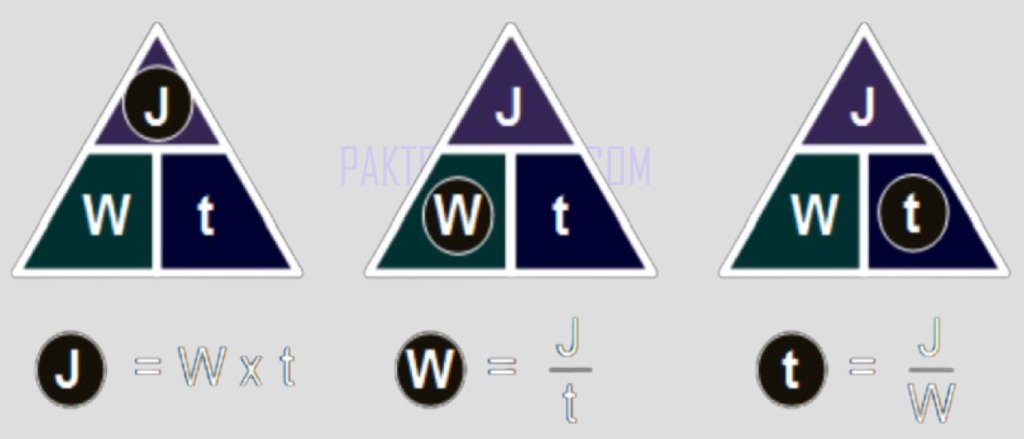Ohm’s Law is a fundamental principle in electrical, electronics engineering and physics that describes the relationship between voltage, current, and resistance in an electrical circuit. It is typically stated as:
V = I x R
To calculate Current (I): I = V / R
To calculate Resistance (R): R = V ÷ I
Where:
- V is the voltage (potential difference) across the electrical component, measured in volts (V).
- I is the current flowing through the component, measured in amperes (A).
- R is the resistance of the component, measured in ohms (Ω).
Ohm’s Law states that the voltage across a resistor is directly proportional to the current flowing through it, with the proportionality constant being the resistance.
- If the resistance ( R ) is constant, increasing the voltage ( V ) will result in a proportional increase in current ( I ).
- Conversely, for a given voltage ( V ), an increase in resistance ( R ) will result in a decrease in current ( I ).
- Ohm’s Law is applicable to many electrical circuits but may not hold in non-linear or complex circuits where resistance changes with voltage or current.
Understanding Ohm’s Law is essential for analyzing and designing electrical and electronic circuits, as it helps predict how much current will flow through a component for a given voltage, or what voltage is needed to achieve a desired current.
Ohms Law Triangle.
The Ohm’s Law triangle is a visual aid that helps remember and apply Ohm’s Law. The triangle is divided into three sections, each representing one of the variables in Ohm’s Law: voltage (V), current (I), and resistance (R). Here’s how it looks and how to use it:

What are Ohmic and Non-Ohmic Devices?
Ohmic devices follow Ohm’s law, which states that the current through a conductor between two points is directly proportional to the voltage across the two points. Examples are resistors, cables (for a wide range of voltages), most metallic conductors.
Non-Ohmic devices do not follow Ohm’s law. Their resistance changes with the applied voltage or current. Examples are diodes, transistors, thermistors, and many semiconductor devices exhibit non-Ohmic behavior.
Electrical power in circuits.
Electrical power in circuits is a crucial concept that relates to how energy is transferred and used in electrical systems. Electrical power is the rate at which electrical energy is transferred by an electric circuit. It is the product of voltage (V) and current (I) in the circuit.
Electrical power (P) is given by the formula: P = VI
P: Power in watts (W)
V: Voltage in volts (V)
I: Current in amperes (A)
Power and Energy: While power measures the rate of energy transfer, energy itself (in watt-hours, Wh, or joules, J) is the product of power and time. For example, 1 watt-hour is the energy consumed when 1 watt of power is used for 1 hour.
Power in AC Circuits: For alternating current (AC) circuits, power can vary over time due to the alternating nature of voltage and current. In AC circuits, the average power over a complete cycle is often considered, which is given by:
P = Vrms×Irms × cos(ϕ)
where Vrms and Irms are the root mean square values of voltage and current, and Φ is the phase angle between them.
Important of Electrical Power.
Heating and Energy Consumption: Electrical power is directly related to the amount of heat generated by a device or circuit, as P = VI implies energy conversion into heat or other forms of energy in the circuit’s components.
Efficiency and Ratings: It is used to determine the efficiency of devices and the maximum load they can handle safely without overheating.
Measurement and Calculation: Measuring electrical power is essential for billing purposes in residential and industrial settings, and for ensuring that electrical devices operate within their specified power ratings.
Power Triangle.
The power triangle is a graphical representation used in AC circuits to illustrate the relationship between real power, reactive power, and apparent power. Understanding the power triangle helps in analyzing and managing power systems, especially those involving inductive and capacitive loads.

In electrical circuits, power can be either positive or negative, and this depends on the direction of energy flow.
Power is considered positive when energy is being consumed or used by the load. In this case, the power flow is from the source (such as a power supply or battery) to the load (such as a resistor, motor, or any other electrical device).
Mathematically, positive power is indicated when the voltage and current have the same direction (i.e., the product of voltage and current is positive). P=VI (where V and I are in phase).
Power is considered negative when energy is being supplied back to the source. This situation typically occurs in circuits with reactive components or when energy is being generated rather than consumed.
Mathematically, Negative power is indicated when the voltage and current are out of phase by 180 degrees, meaning the product of voltage and current is negative.
P = −VI (where V and I are 180 degrees out of phase).
Negative power can be seen in scenarios such as regenerative braking in electric vehicles, where the motor acts as a generator, feeding power back to the battery. It also occurs in AC circuits with reactive components, where power can flow back and forth due to the presence of inductance and capacitance.
Electrical Power Rating.
The electrical power rating of a device or component indicates the maximum power it can safely handle or consume. The power rating specifies the maximum continuous power that a device can handle without overheating or sustaining damage. It is usually given in watts (W) or kilowatts (kW).
Examples of Power Ratings.
- Light Bulbs: A typical incandescent bulb might have a power rating of 60W.
- Microwave Ovens: Commonly rated between 600W and 1200W.
- Air Conditioners: Rated in BTUs, which can be converted to watts (e.g., 5000 BTU/hr ≈ 1465W).
- Computers: A desktop power supply unit (PSU) might be rated at 500W or more.
- Smartphones: Chargers typically range from 5W to 25W, with fast chargers going up to 65W or more.
Types of Power Ratings.
- Resistive Devices: For devices like heaters, incandescent bulbs, and resistors, the power rating is straightforward and usually denotes the maximum heat dissipation.
- Inductive and Capacitive Devices: For motors, transformers, and other inductive or capacitive components, the power rating might consider factors like phase angles, reactive power, and efficiency.
- Electronic Components: For semiconductors, such as transistors and integrated circuits, the power rating includes considerations for junction temperatures and thermal management.
Ohms Law Pie Chart.

An Ohm’s Law pie chart is a visual tool that helps understand and recall the relationships between voltage (V), current (I), resistance (R), and power (P) in electrical circuits. Ohm’s Law states that V=IR.
When considering power, we use P=VI. The pie chart shows these relationships and helps solve for any one quantity if the o
Ohms Law Matrix Table.

An Ohm’s Law matrix table is a useful tool for quickly referencing and calculating the relationships between voltage (V), current (I), resistance (R), and power (P). It organizes the formulas in a grid format, making it easy to see how each quantity can be derived from the others.
Ohms Law Example.
Sure, let’s go through an example of how to apply Ohm’s Law and related power formulas to solve for unknown quantities in an electrical circuit.

Example Problem
Suppose you have a simple circuit with the following known values:
- Voltage (V) = 12 volts
- Resistance (R) = 6 ohms
We want to find Voltage (V), the Current (I), the Resistance (R) and the Power (P).
Current [ I = V ÷ R ] c= 12 ÷ 6 Ω = 2A
Power [ P = V x I ] = 12 x 2 = 24 W.
Electrical Energy in Circuits.
Electrical energy in circuits refers to the energy transferred by the movement of electric charge through a conductor or a circuit. This energy can be converted into various forms, such as heat, light, mechanical work, or stored energy. Understanding electrical energy is crucial for analyzing the performance, efficiency, and consumption of electrical devices and systems.
It is measured in joules (J) in the International System of Units (SI). However, it is commonly measured in kilowatt-hours (kWh) for practical applications, such as in household electricity usage.
The relationship between energy, power, and time is given by: W=P×t.
Example 1: Energy Consumed by a Light Bulb.
Suppose you have a 60 watt light bulb that is turned on for 5 hours. Calculate the energy consumed.
- Power (P): 60 watts
- Time (t): 5 hours = 5 × 3600 seconds = 18,000 seconds
Using the energy formula:
W=P×t
W =60 W × 18,000 s =1,080,000 J (joules)
To convert joules to kilowatt-hours (kWh):
1kWh = 3,600,000 Joules
W = 1,080,000 J / 3,600,000J = 0.3 kWh
Note: In energy metering 1 kWh is considered as 1 unit.
Energy Triangle.
The Energy Triangle is a visual tool similar to the Power Triangle and Ohm’s Law pie chart. It helps to understand and calculate the relationships between energy (E), power (P), and time (t) in electrical circuits.

Electrical energy consumption in homes, businesses, and industries typically involves large quantities of energy. Measuring this energy in joules (J) would result in extremely large numbers, making it impractical for everyday use. For instance, 1 kilowatt-hour (kWh) is equivalent to 3,600,000 joules (J), a much more manageable figure for billing and communication.
Kilowatt-hours (kWh) provide a convenient and straightforward way to quantify electrical energy consumption. It simplifies calculations and comparisons. For instance, it’s easier to say an appliance uses 2 kWh per day rather than 7,200,000 joules.
The utility industry worldwide has standardized the use of kilowatt-hours for billing purposes. Electric meters are calibrated to measure energy consumption in kWh, simplifying the billing process and making it easier for consumers to understand their energy usage.
The kilowatt-hour (kWh) is the standard unit of energy used by utility companies to measure electricity consumption. One kWh represents the energy consumption of a device that uses 1 kilowatt of power for 1 hour.